The Dyson Purifier Hot+Cool Formaldehyde (HP09) extracts and catalytic converts harmful Formaldehyde while purifying the air and cooling or heating your home.
It is one of the Dyson Purifier hot+cool or cool range with a 99.95% removal of pollutants and gasses as small as 1um.
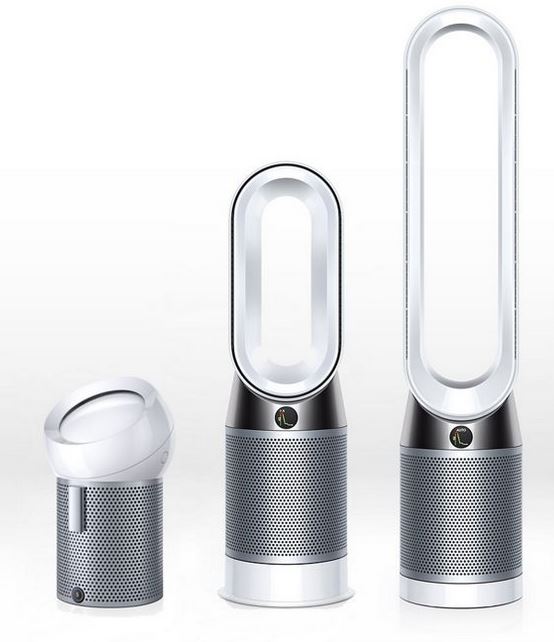
You need to understand the dangers of Formaldehyde, used amongst other things, to embalm corpses
Dyson Purifier Hot+Cool Formaldehyde (HP09)
| Website | Product page |
| Price | $1099 with free shipping and bonus filter from Dyson.com.au |
| From | Retailers including Harvey Norman, The Good Guys, JB Hi-Fi, Bing Lee, Myer and David Jones |
| Colour | White/Gold |
| Country of manufacture | Malaysia |
| Warranty | 2-year parts and labour ACL warranty including transport costs both ways |
| Company | Dyson is a British company that employs more than 14,000 people and 6,000 engineers who constantly look for better ways. Its core technologies and patents revolve around cyclonic and Coandă air movement (like the multiplier effect of the purifier), high-performance batteries, high-RPM DC motors (like the fan in the purifier), machine learning and AI (used in the Dyson App) and its hair labs for the Dyson Supersonic, Airwrap and Corrale straightener. |
| More | CyberShack Dyson news and reviews |

Formaldehyde kills – true or hype?
Cancer.gov, states
Individuals repeatedly exposed to Formaldehyde include the workers making it, lab technicians, and morticians. The chemical is dangerous in the air at a level of more than 0.1 ppm (one part per million). It can cause adverse effects like coughing, nausea, watery eyes, skin irritation and a burning sensation around the nose and eyes. The International Agency for Research on Cancer and the National Toxicology Program classifies it as a human carcinogen. National Cancer Institute investigators have concluded that prolonged exposure may cause human myeloid leukemia.
I am not a scientist or toxicologist – we will leave that to the experts. Dyson believes that Formaldehyde elimination is worth the effort and not just another way to sell air purifiers.
Dyson’s Selective Catalytic Oxidisation (SCO) filter continuously destroys Formaldehyde at a molecular level. The catalytic filter has a unique coating with the same structure as the Cryptomelane mineral. Its billions of atom-sized tunnels are the optimal size and shape to trap and destroy Formaldehyde. It breaks it down into tiny amounts of water (H20) and carbon dioxide (CO2). It then regenerates from oxygen in the air to continuously destroy it without ever requiring replacement.
Is Formaldehyde an issue at home?
Ironically it’s a 21st-century problem. Formaldehyde is in the air we breathe, at around 0.03ppm (approx. 1/3rd of the Cancer.gov dangerous level).
The primary source is automotive use, pressed-wood particleboard, plywood, and fibreboard from urea-based glue. It is also in permanent-press fabrics, paper product coatings, disposable nappies and insulation materials. You will find it most industrial fungicide, germicides, and disinfectants.
Many live in a flat-pack world, in high–rise apartments with recirculated air conditioning, and don’t open windows. As we can’t give up our flat pack addiction (tried to buy real wood furniture lately), we must remove it from the air
If you live in an older home with wide-open windows, you should not have an issue until installing compressed hardwood or faux wood flooring.
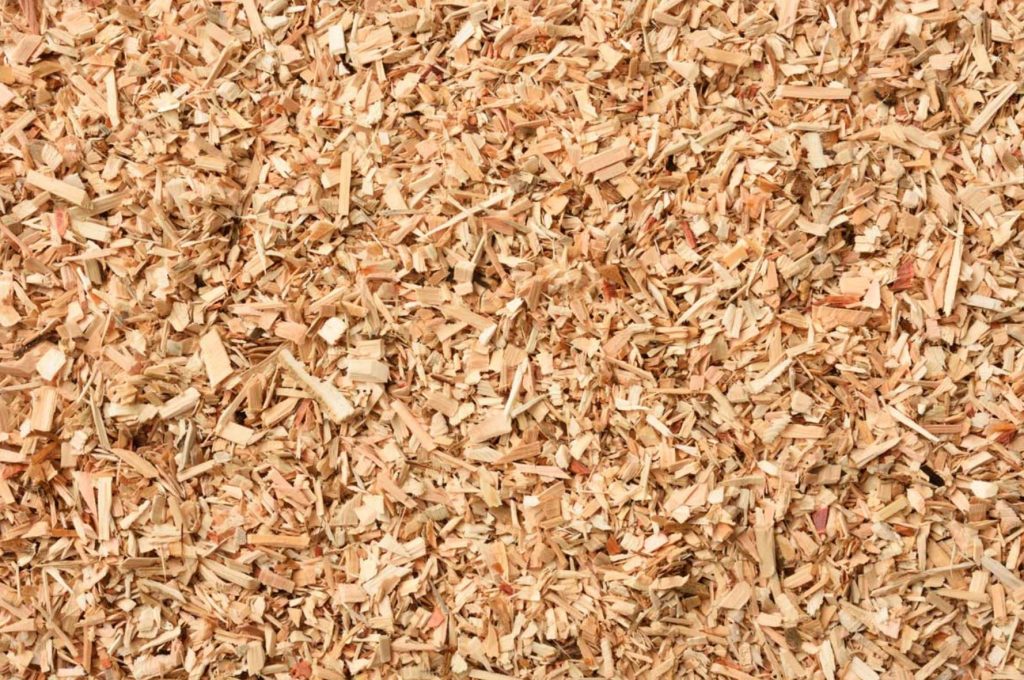


Does the Dyson Purifier Hot+Cool Formaldehyde (HP09) work?
Yes. Formaldehyde’s chemical equation is CH2O – one carbon molecule, two hydrogen molecules and one oxygen molecule. It breaks down quickly under sunlight to carbon (C or black soot) and water (H2O) when released outside.
Dyson has invented and patented two technologies.
First is a ‘catalytic converter’ (a catalyst that causes something to happen without being used in the process) that breaks Formaldehyde down to tiny amounts of water (H20) and carbon dioxide (CO2). It lasts a lifetime because it regenerates during the process.
The second is a new type of Formaldehyde sensor. This was the province of an expensive exhaustible gel to detect it. Dyson’s solid-state detector measures mg/m3 – hard as formaldehyde gas is 500 times smaller than particles trapped in its HEPA and activated charcoal filters.
No other consumer air purifier can remove Formaldehyde (gas – not a particle) via HEPA or Activated charcoal filters – any claims otherwise are pure fantasy.
First impression
- Dyson style – sleek, tall, bladeless air circulator, metal air intake grill and the plethora of information it shows on the colour LCD and the Dyson app. Dyson now answers to OK Google!
- Dyson build quality – no faux metal or cheap plastic parts. It oozes quality – I have a decade old Dyson fan/heater AM04 that still looks and works like new.
- Dyson service – if you need warranty support, they send you a prepaid shipping carton. It is quickly repaired or replaced then sent back prepaid. You can’t beat that.
- Dyson tech – it correctly uses the Coandă effect ( an air multiplier and jet focus), which produces at least 10x times the airflow from a smaller device. It is perfect for creating micro-climates with good energy efficiency. Not to forget the unique Formaldehyde killer.
- That is why this costs $1099 – if you question the price, it is not for you. And if you don’t have a Formaldehyde problem, the Dyson Purifier Hot+Cool purifying fan heater (black/nickel or white/silver) HP00 at $699 may be just right for you.
CADR – not the way to measure a Dyson
Most air purifiers quote CADR (clean air delivery rate). In theory, the higher CADR, the larger room it can purify. Except that most air purifiers are a) static towers that sit in the corner of the room and b) suck in the air adjacent to them.
Dyson not only sucks air in from all around (360°) but also expels it out of the bladeless fan using the Coandă effect (how air flows over an aircraft wing creating uplift), pulling along at least 10x times air it expels. That means it can clean more air faster (air clean rate) from more areas in the room than a standard purifier.
On fan speed 10 (max), this has a rate of 314 Litres/second by the 10x multiplier = 113,040 L/Hr or CADR of 113m3/hr. For comparison, a standard bedroom is about 25m3, so it would clean all the air four times. But you are more likely to use a lower fan speed (say 5), so that is two times – well above accepted CADR rates. And once the air is clean, as long as doors and windows are closed, it remains clean.
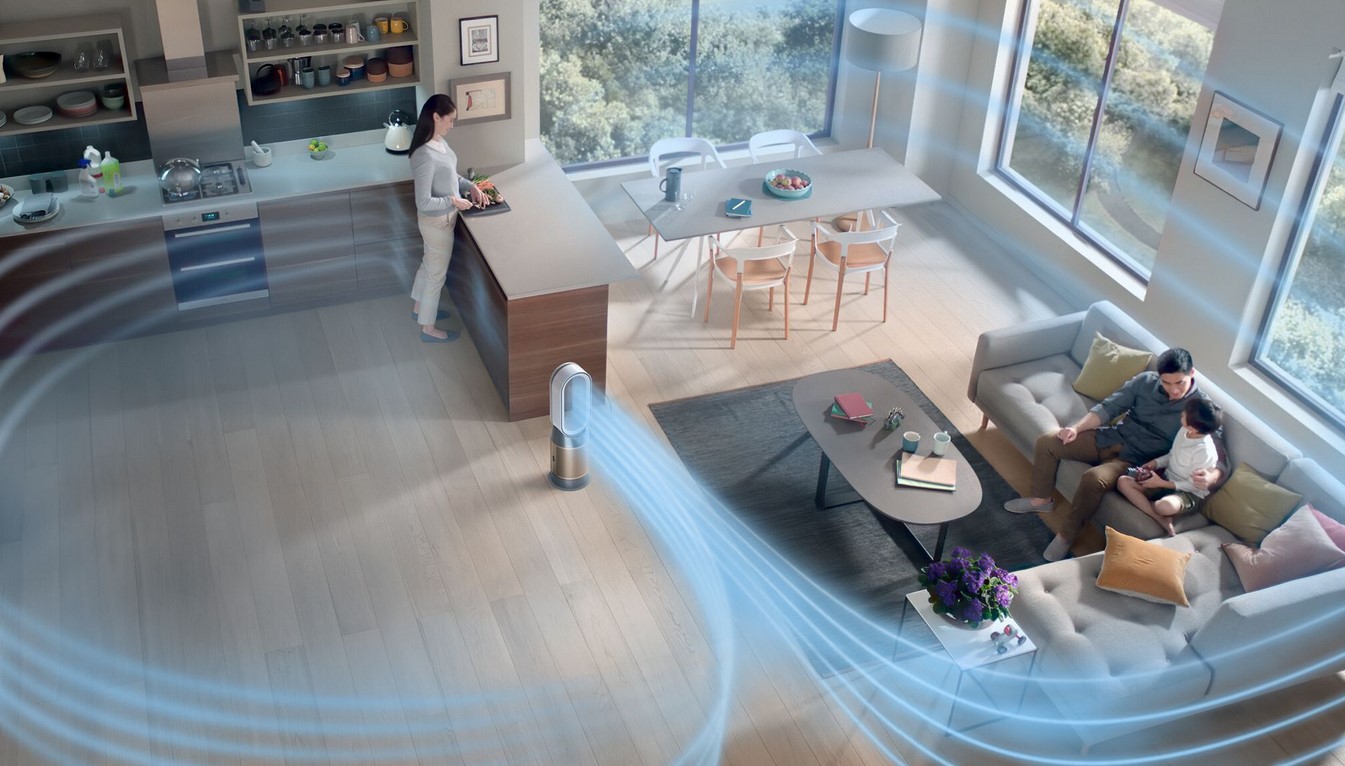 The Coanda effect makes this suitable for larger spaces
The Coanda effect makes this suitable for larger spaces
Airflow – its a bladeless fan
Dyson wins hands down over a static tower purifier – it is a bladeless fan!
- Out the front with a Coandă Effect moving quite a lot of air in a gentle fan motion – not a gale
- Out the back – diffused and no Coandă
- 350° oscillation programable in 45° steps
- Tilt adjustment
- Night-time mode
- You can use it as a fan or a heater
Filter efficiency -excellent and low cost replacements
First, you need to know what it senses and traps.
The sealed system HEPA and Carbon filter capture most gases and 99.95% of particles as small as 0.1 microns. That means Pollen and allergens, bacteria, and ultrafine particles – nothing escapes. It has a life of about 4000 hours (two years at 8 hours a day) – the machine will tell you when to change it.
Gases include odours (cooking fumes and flatulence), Benzene, Nitrogen Dioxide (auto exhaust, tobacco, wood/gas burning) and VOCs (Volatile organic compounds). VOCs are wide-ranging – far too many to list, but generally come from paint, cleaning supplies, pesticides, glues etc. and are up to five times more concentrated inside a home.
We have discussed Formaldehyde, and the Dyson Purifier Hot+Cool Formaldehyde (HP09) has a separate lifetime catalyst that fits inside the filter unit and destroys, not traps it.
The 360° HEPA and activated carbon filter works with the HP09, HP07, HP04, TP07, TP04 and DP04 and cost $99 including freight – quite reasonable.
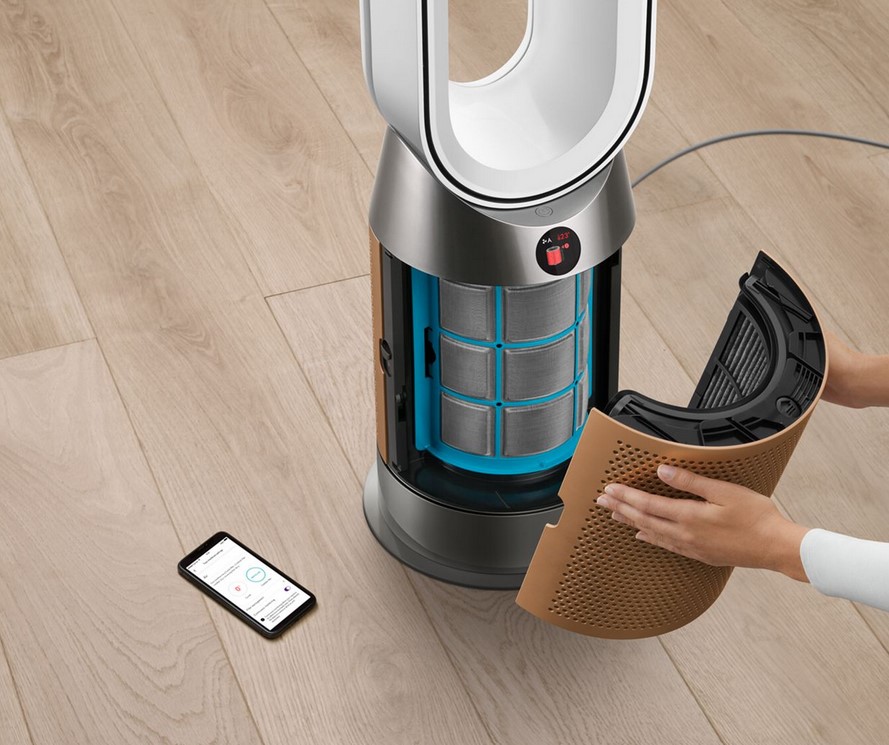
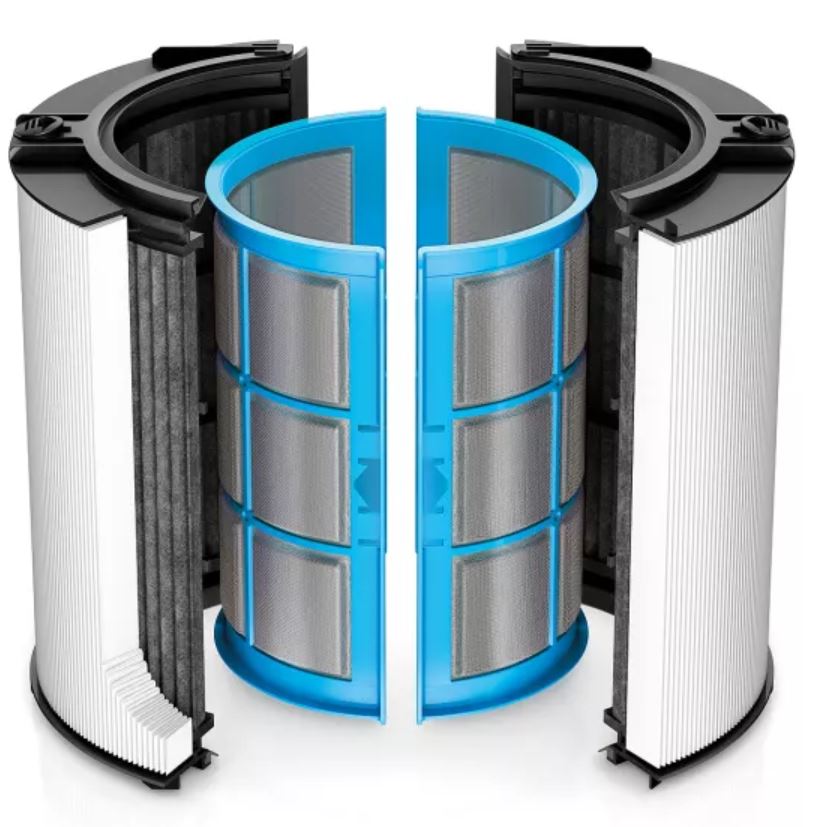
LCD indicator – lets you know at a glance
The colour screen is highly informative. It tells you PM2.5, PM10, HCHO, VOC, NO2, Filter status, air quality over the past few hours and 24 hours. It also shows current room temperature, humidity, Wi-Fi setup, and fan/airflow speed.
The information is also in the Dyson app. It is also a remote control. If you like to know about your environment, there is no better app. There is one caveat – you need to enable continuous monitoring. Oh, and it is now Google Assistant and Alexa capable.
Safety – childproof
It has a 25.8cm base (stable), a 76.4cm height and weighs 5.5kg.
They are ultra-safe around children as they have no fan blades or hot surfaces. But the tower can present a tripping hazard to small children, although the weight is probably insufficient to do any damage.
Sound level
Noise at 1m ranges from 20dB (fan 1) to 61dB (fan 10). It depends on fan speeds and, to some degree, the surface it sits on. In all, up to fan speed five is below 40dB
Power
It has a 1.8m wall plug cable. Depending on fan speed and temperature, it can go from idle (fraction of a watt) to up to 2500W.
At fan speed 5 and 23° heat, it ambles along at about 300-500W – use it for 8 hours overnight in a bedroom costs about $1 (25 cents per kWh). As a fan/purifier, the energy used varies from 25 to 150W. It is economical.
Microclimate heater
One of the Dyson design advantages is creating a microclimate to focus the airflow over a smaller area via tilt and radius oscillation from 0-350° in 45° increments.
Let’s say you are in a large open space kitchen/dining/lounge; you can heat an area about 2 metres wide up to 3 metres away – that cosy lounge where you watch TV. Remember that few (if any) currently available air purifiers are fans and heaters.
CyberShack’s view – Dyson Purifier Hot+Cool Formaldehyde (HP09) cures new-world problems
If you don’t have a formaldehyde problem, don’t buy it. The Dyson Pure Hot+Cool HP00 at $699 is virtually identical apart from Wi-Fi connectivity.
If you live with a smoker or in an apartment – flat pack heaven, faux wood flooring and faux leather couches – and rely on recirculated air-conditioning, this device is a no-brainer.
Finally, let me repeat the warning – consumer air purifiers don’t destroy Formaldehyde. As far as we can tell, Dyson is the only destroyer.
Watch from 2:30 – its 13 minutes but may help you decide to open your wallet
Dyson Purifier Hot+Cool Formaldehyde (HP09)
$1099

Pros
- High tech information – use with and without an app
- Easy to use – remote control and app control
- Efficient fan/heater/air purifier/formaldehyde killer for year-round use
- Cleans the air faster than a non-fan purifier– forget about CADR
- Recommended for a large home, open space or office spaces
Cons
- epending on use, the HEPA filter needs replacing every 12-24 months


[ad_2]
Originally Appeared Here